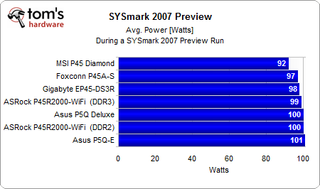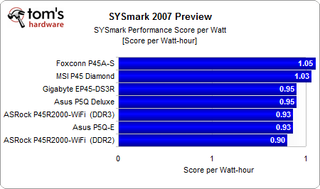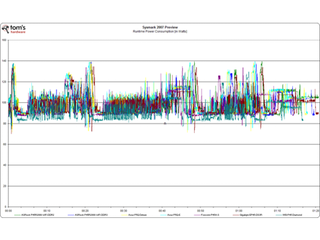Power-Saving Motherboards: Fact Or Fiction?
SYSmark 2007 Power And Performance Per Watt
First let’s consider the average power requirements during an entire SYSmark 2007 run and the total power required to complete the benchmark. Remember that Foxconn, with no power-saving features, performs best overall.

Most of the boards are similar when it comes to average power requirements, with the MSI motherboard demonstrating the lowest average power requirement.

The MSI P45 Diamond requires the least power (118 Wh) in terms of Watt-hours consumed by the test systems to complete a SYSmark 2007 run; it’s followed by the Foxconn P45A-S (120 Wh), which doesn’t even come with a power-management feature. Asus and Gigabyte fall in the middle (130 Wh to 131 Wh), and the ASRock board consumes the most energy (150 Wh). It’s nice to see that the DDR3 memory helps save some power as well, despite our using four DDR3 DIMMs versus only two DDR2 DIMMs at default voltages.

How does this translate into SYSmark scores per Watt-hour? The winner is Foxconn’s P45A-S, with 1.05 Wh SYSmark 2007 scores, despite its lack of power-saving optimization features. The MSI P45 Diamond, which has the most effective power-saving implementation, lands in second place. Gigabyte, which has made news as one of the first motherboard makers to provide DES power-saving, ends in third place with DES enabled. Asus, which uses its EPU power-saving technology, gets the same per-Watt-hour performance scores as the Gigabyte EP45-DS3R, but the Asus P5Q-E still can’t beat the ASRock boards with no power-optimization features.

The power-consumption diagram for the SYSmark 2007 run illustrates the total run time (see Y axis) and the power consumed at every moment during the benchmark (X axis), and proves what we’ve found so far: MSI’s P45 Diamond is more power-efficient than competitors, and Foxconn’s P45A-S is faster.
Stay on the Cutting Edge
Join the experts who read Tom's Hardware for the inside track on enthusiast PC tech news — and have for over 25 years. We'll send breaking news and in-depth reviews of CPUs, GPUs, AI, maker hardware and more straight to your inbox.
Current page: SYSmark 2007 Power And Performance Per Watt
Prev Page Test Setup, SYSmark 2007 Results Next Page Power MeasurementsMost Popular

